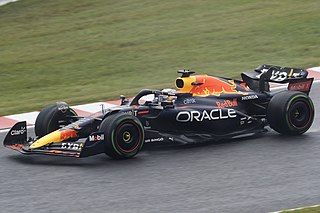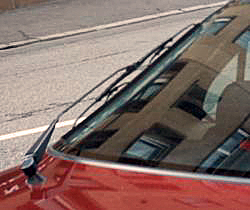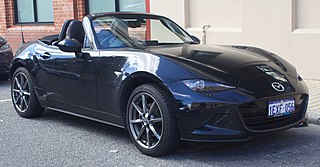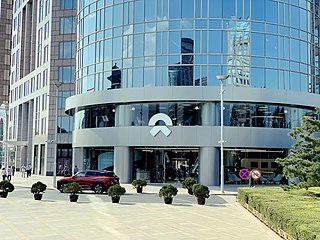
In cinematography, a tracking shot is any shot where the camera follows backward, forward or moves alongside the subject being recorded. Often the camera is mounted on a camera dolly which rides on rails similar to a railroad track; in this case, the shot is referred to as a dolly shot. A handheld steadycam or gimbal may also be used for smaller scale productions. The camera is then pushed along the track while the scene is being filmed, or moved manually when using a handheld rig. The effect can be used to create a sense of movement, to follow a character or object, or a sense of immersion to draw the viewer into the action.

A coupe or coupé is a passenger car with a sloping or truncated rear roofline and two doors.

Motorsport(s), or motor sport(s), are sporting competitions and activities that primarily involve the use of automobiles. Historically, the terms have encompassed sporting use of other motorised vehicles including motorcycles, motorboats and powered aircraft, however, specific terms are now more commonly used in these latter areas such as motorcycle sport, power boating and air sports.

A watercraft or waterborne vessel is any vehicle designed for travel across or through water bodies, such as a boat, ship, hovercraft, submersible or submarine.

A sedan or saloon is a passenger car in a three-box configuration with separate compartments for an engine, passengers, and cargo. The first recorded use of sedan in reference to an automobile body occurred in 1912. The name derives from the 17th-century litter known as a sedan chair, a one-person enclosed box with windows and carried by porters. Variations of the sedan style include the close-coupled sedan, club sedan, convertible sedan, fastback sedan, hardtop sedan, notchback sedan, and sedanet/sedanette.

A windscreen wiper or windshield wiper is a device used to remove rain, snow, ice, washer fluid, water, or debris from a vehicle's front window. Almost all motor vehicles, including cars, trucks, buses, train locomotives, and watercraft with a cabin—and some aircraft—are equipped with one or more such wipers, which are usually a legal requirement.

A stable is a building in which livestock, especially horses, are kept. It most commonly means a building that is divided into separate stalls for individual animals and livestock. There are many different types of stables in use today; the American-style barn, for instance, is a large barn with a door at each end and individual stalls inside or free-standing stables with top and bottom-opening doors. The term "stable" is also used to describe a group of animals kept by one owner, regardless of housing or location.

A roadster is an open two-seat car with emphasis on sporting appearance or character. Initially an American term for a two-seat car with no weather protection, usage has spread internationally and has evolved to include two-seat convertibles.

Coupé de ville — also known as town car or sedanca de ville — is a car body style produced from 1908 to 1939 with an external or open-topped driver's position and an enclosed compartment for passengers. Although the different terms may have once had specific meanings for certain car manufacturers or countries, the terms are often used interchangeably.

Touring car and tourer are both terms for open cars. "Touring car" is a style of open car built in the United States which seats four or more people. The style was popular from the early 1900s to the 1930s. The cars used for touring car racing in various series since the 1960s, are unrelated to these early touring cars, despite sharing the same name.

A notchback is a design of a car with the rearmost section that is distinct from the passenger compartment and where the back of the passenger compartment is at an angle to the top of what is typically the rear baggage compartment. Notchback cars have "a trunk whose lid forms a distinct deck." In profile view, the body has a step down from the roof with a downward inclined passenger compartment's rear window to meet an almost horizontal trunk lid extending to the rear of the car.

The trunk or boot of a car is the vehicle's main storage or cargo compartment, often a hatch at the rear of the vehicle. It can also be called a tailgate.

A cabrio coach or semi-convertible is a type of car that has a retractable textile roof, similar to a convertible/cabriolet. The difference is that where a convertible often has the B-pillar, C-pillar and other bodywork removed, the cabrio coach retains all bodywork to the top of the door frames and just replaces the roof skin and rear window with a retractable fabric panel.
A glossary of terms relating to automotive design.

Retrofitting is the addition of new technology or features to older systems. Retrofits can happen for a number of reasons, for example with big capital expenditures like naval vessels, military equipment or manufacturing plants, businesses or governments may retrofit in order to reduce the need to replace a system entirely. Other retrofits may be due to changing codes or requirements, such as seismic retrofit which are designed strengthening older buildings in order to make them earthquake resistant.

Quarter glass on automobiles and closed carriages may be a side window in the front door or located on each side of the car just forward of the rear-facing rear window of the vehicle. Only some cars have them. In some cases, the fixed quarter glass may set in the corner or "C-pillar" of the vehicle. Quarter glass is also sometimes called a valence window.(AKA quarter lite)

A sliding door is a type of door that is mounted on or suspended from a track for the door to slide, usually horizontally and outside. It is a feature predominantly relegated to minibuses and buses, to provide a large entrance or exit for passengers without obstructing the adjacent pathway between the vehicle and any adjoining object or the side(s) of a passenger, and commercial vans, so as to allow a larger unobstructed access to the interior for loading and unloading.

The Tesla Model X is a battery electric mid-size luxury crossover SUV built by Tesla, Inc. since 2015. Developed from the full-sized sedan platform of the Tesla Model S, the vehicle notably uses falcon wing doors for passenger access.
Cambodian vehicle license plates are the license plates attached to most motorized road vehicles in Cambodia, which are required by law. Cambodian license plates display the name of the province where the vehicle was registered. The owner must register the car in the province they live; this can be a different province from where the owner has his official residence. If the title to the car is transferred to someone else, and the new owner lives in a different province, the number usually changes.

Nio Inc. is a Chinese multinational automobile manufacturer headquartered in Shanghai, specializing in designing and developing electric vehicles. The company develops battery-swapping stations for its vehicles, as an alternative to conventional charging stations. The company has raised over $5 billion from investors. In 2021, Nio announced plans to expand to 25 different countries and regions by 2025.



















